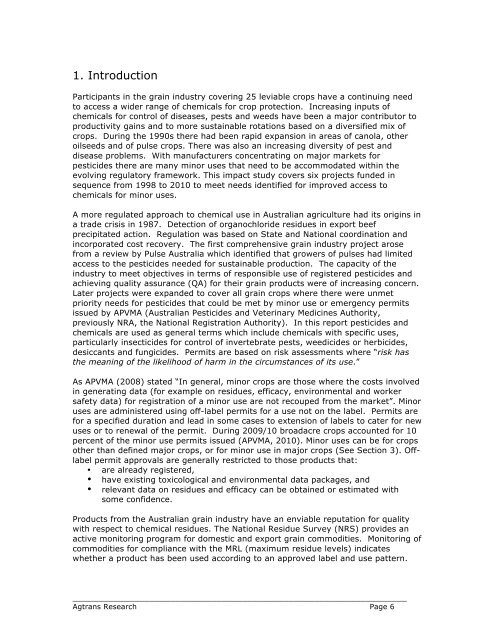An Economic Analysis of GRDC Investment in Minor Use Chemicals
An Economic Analysis of GRDC Investment in Minor Use Chemicals
An Economic Analysis of GRDC Investment in Minor Use Chemicals
You also want an ePaper? Increase the reach of your titles
YUMPU automatically turns print PDFs into web optimized ePapers that Google loves.
1. Introduction<br />
Participants <strong>in</strong> the gra<strong>in</strong> <strong>in</strong>dustry cover<strong>in</strong>g 25 leviable crops have a cont<strong>in</strong>u<strong>in</strong>g need<br />
to access a wider range <strong>of</strong> chemicals for crop protection. Increas<strong>in</strong>g <strong>in</strong>puts <strong>of</strong><br />
chemicals for control <strong>of</strong> diseases, pests and weeds have been a major contributor to<br />
productivity ga<strong>in</strong>s and to more susta<strong>in</strong>able rotations based on a diversified mix <strong>of</strong><br />
crops. Dur<strong>in</strong>g the 1990s there had been rapid expansion <strong>in</strong> areas <strong>of</strong> canola, other<br />
oilseeds and <strong>of</strong> pulse crops. There was also an <strong>in</strong>creas<strong>in</strong>g diversity <strong>of</strong> pest and<br />
disease problems. With manufacturers concentrat<strong>in</strong>g on major markets for<br />
pesticides there are many m<strong>in</strong>or uses that need to be accommodated with<strong>in</strong> the<br />
evolv<strong>in</strong>g regulatory framework. This impact study covers six projects funded <strong>in</strong><br />
sequence from 1998 to 2010 to meet needs identified for improved access to<br />
chemicals for m<strong>in</strong>or uses.<br />
A more regulated approach to chemical use <strong>in</strong> Australian agriculture had its orig<strong>in</strong>s <strong>in</strong><br />
a trade crisis <strong>in</strong> 1987. Detection <strong>of</strong> organochloride residues <strong>in</strong> export beef<br />
precipitated action. Regulation was based on State and National coord<strong>in</strong>ation and<br />
<strong>in</strong>corporated cost recovery. The first comprehensive gra<strong>in</strong> <strong>in</strong>dustry project arose<br />
from a review by Pulse Australia which identified that growers <strong>of</strong> pulses had limited<br />
access to the pesticides needed for susta<strong>in</strong>able production. The capacity <strong>of</strong> the<br />
<strong>in</strong>dustry to meet objectives <strong>in</strong> terms <strong>of</strong> responsible use <strong>of</strong> registered pesticides and<br />
achiev<strong>in</strong>g quality assurance (QA) for their gra<strong>in</strong> products were <strong>of</strong> <strong>in</strong>creas<strong>in</strong>g concern.<br />
Later projects were expanded to cover all gra<strong>in</strong> crops where there were unmet<br />
priority needs for pesticides that could be met by m<strong>in</strong>or use or emergency permits<br />
issued by APVMA (Australian Pesticides and Veter<strong>in</strong>ary Medic<strong>in</strong>es Authority,<br />
previously NRA, the National Registration Authority). In this report pesticides and<br />
chemicals are used as general terms which <strong>in</strong>clude chemicals with specific uses,<br />
particularly <strong>in</strong>secticides for control <strong>of</strong> <strong>in</strong>vertebrate pests, weedicides or herbicides,<br />
desiccants and fungicides. Permits are based on risk assessments where “risk has<br />
the mean<strong>in</strong>g <strong>of</strong> the likelihood <strong>of</strong> harm <strong>in</strong> the circumstances <strong>of</strong> its use.”<br />
As APVMA (2008) stated “In general, m<strong>in</strong>or crops are those where the costs <strong>in</strong>volved<br />
<strong>in</strong> generat<strong>in</strong>g data (for example on residues, efficacy, environmental and worker<br />
safety data) for registration <strong>of</strong> a m<strong>in</strong>or use are not recouped from the market”. M<strong>in</strong>or<br />
uses are adm<strong>in</strong>istered us<strong>in</strong>g <strong>of</strong>f-label permits for a use not on the label. Permits are<br />
for a specified duration and lead <strong>in</strong> some cases to extension <strong>of</strong> labels to cater for new<br />
uses or to renewal <strong>of</strong> the permit. Dur<strong>in</strong>g 2009/10 broadacre crops accounted for 10<br />
percent <strong>of</strong> the m<strong>in</strong>or use permits issued (APVMA, 2010). M<strong>in</strong>or uses can be for crops<br />
other than def<strong>in</strong>ed major crops, or for m<strong>in</strong>or use <strong>in</strong> major crops (See Section 3). Offlabel<br />
permit approvals are generally restricted to those products that:<br />
• are already registered,<br />
• have exist<strong>in</strong>g toxicological and environmental data packages, and<br />
• relevant data on residues and efficacy can be obta<strong>in</strong>ed or estimated with<br />
some confidence.<br />
Products from the Australian gra<strong>in</strong> <strong>in</strong>dustry have an enviable reputation for quality<br />
with respect to chemical residues. The National Residue Survey (NRS) provides an<br />
active monitor<strong>in</strong>g program for domestic and export gra<strong>in</strong> commodities. Monitor<strong>in</strong>g <strong>of</strong><br />
commodities for compliance with the MRL (maximum residue levels) <strong>in</strong>dicates<br />
whether a product has been used accord<strong>in</strong>g to an approved label and use pattern.<br />
_________________________________________________________________<br />
Agtrans Research Page 6

















